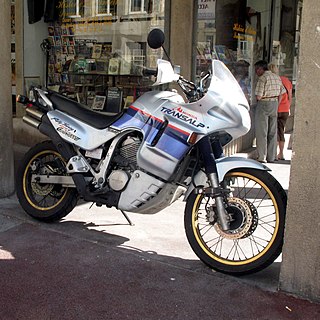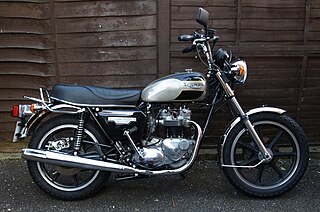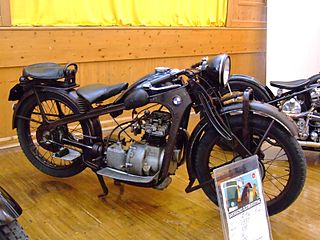
An anti-lock braking system (ABS) is a safety anti-skid braking system used on aircraft and on land vehicles, such as cars, motorcycles, trucks and buses. ABS operates by preventing the wheels from locking up during braking, thereby maintaining tractive contact with the road surface.
Indian is an American brand of motorcycles originally produced from 1901 to 1953 in Springfield, Massachusetts, United States. Hendee Manufacturing Company initially produced the motorcycles, but the name was changed to the Indian Motocycle Manufacturing Company in 1928.
The Honda XR series is a range of four-stroke off-road motorcycles that were designed in Japan but assembled all over the world.

A motorcycle engine is an engine that powers a motorcycle. Motorcycle engines are typically two-stroke or four-stroke internal combustion engines, but other engine types, such as Wankels and electric motors, have been used.

The Harley-Davidson Sportster is a line of motorcycles produced continuously since 1957 by Harley-Davidson. Sportster models are designated in Harley-Davidson's product code by beginning with "XL". In 1952, the predecessors to the Sportster, the Model K Sport and Sport Solo motorcycles, were introduced. These models K, KK, KH, and KHK of 1952 to 1956 had a sidevalve engine, whereas the later XL Sportster models use an overhead valve engine. The first Sportster in 1957 had many of the same details of the KH including the frame, fenders, large gas tank and front suspension.

Rickman Motorcycles was a British, independent motorcycle chassis constructor established by brothers Derek and Don Rickman. The firm manufactured motorcycles from 1960 through to 1975.

The Triumph Bonneville is a standard motorcycle featuring a parallel-twin four-stroke engine and manufactured in three generations over three separate production runs.

The Honda Transalp is the name given to the XL400V, XL600V, XL650V, and XL700V series of dual-sport motorcycles manufactured in Japan by Honda since 1987. The Transalp bikes all feature a liquid-cooled, four-stroke 52° V-twin engine.

The VT250 or Spada MC20 was a Honda motorcycle built between late 1988 and the end of 1989.

The Vincent Rapide is a line of standard motorcycles designed and built by the Vincent HRD motorcycle company at their works in Great North Road, Stevenage, Hertfordshire, England. The model debuted in 1936 and was built until 1939. Production resumed in 1946 and ended in 1955. Four major versions were built, labelled Series A through D.

The T140W TSS was the last motorcycle model made by Triumph Engineering at their Meriden factory.

The Royal Enfield Bullet was originally a British overhead valve single cylinder four-stroke motorcycle made by Royal Enfield in Redditch, Worcestershire, now produced by Royal Enfield (India) at Chennai, Tamil Nadu, a company originally founded by Madras Motors to build Royal Enfield motorcycles under licence in India. The Royal Enfield Bullet has the longest unchanged production run of any motorcycle having remained continuously in production since 1948. The Bullet marque is even older, and has passed 75 years of continuous production. The Royal Enfield and Bullet names derive from the British company having been a subcontractor to Royal Small Arms Factory in Enfield, London.

The Triumph Bonneville T140 is a standard motorcycle with a 750 cc (46 cu in) capacity engine that was designed and built by Triumph Engineering at Meriden near Coventry.

The BMW R2 was a 198 cc overhead valve single-cylinder motorcycle produced by BMW between 1931 and 1936, the smallest motorcycle ever produced by the firm. Despite its much smaller design and engine capacity, the R2 retained many features of the larger boxer twin motorcycles in the range, such as cardan shaft drive and a pressed-steel duplex frame. The R2 was the smallest in the range of singles produced during the 1930s by BMW, with its big brothers being the 305 cc R3 and the 400 cc R4.

The Moto Guzzi Stelvio 1200 is a dual-sport motorcycle manufactured by the Italian company Moto Guzzi since 2007.

Flathead motorcycles are a type of bike that was a standard for pre-war motorcycles, in particular US V-twins such as Harley-Davidson and Indian, some British singles, BMW flat twins and Russian copies thereof.
The Royal Enfield Interceptor 650 is a 270° parallel twin retro-styled motorcycle introduced by Royal Enfield (India) in 2018. It is the first modern twin cylinder motorcycle developed by the company.





















